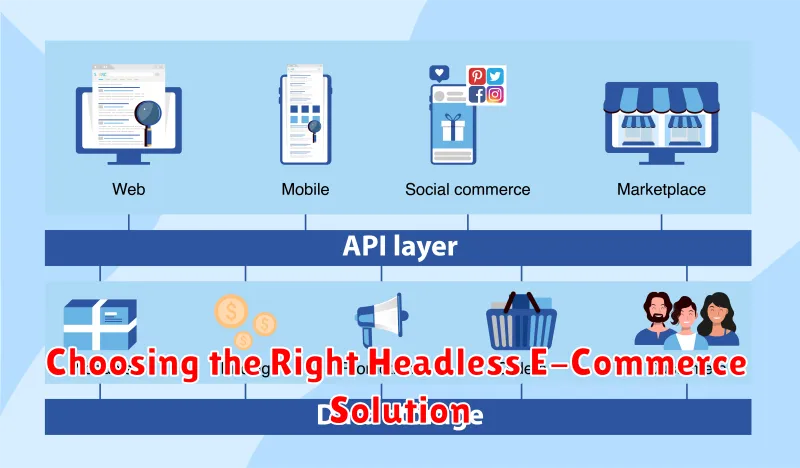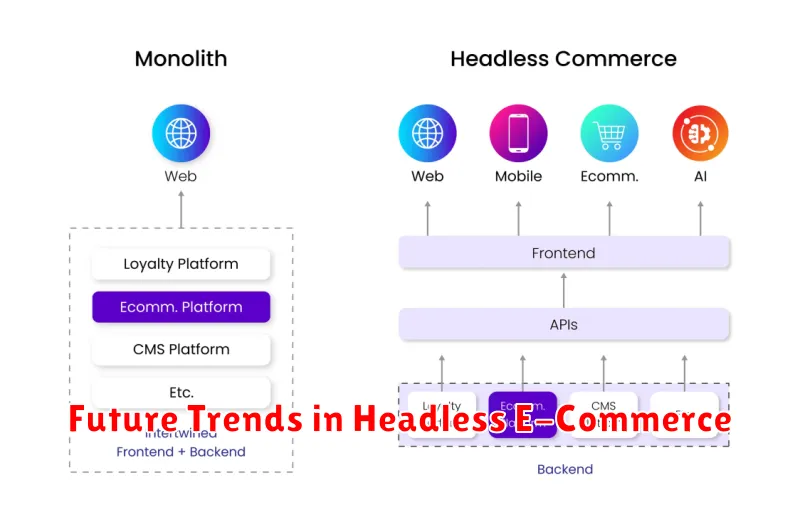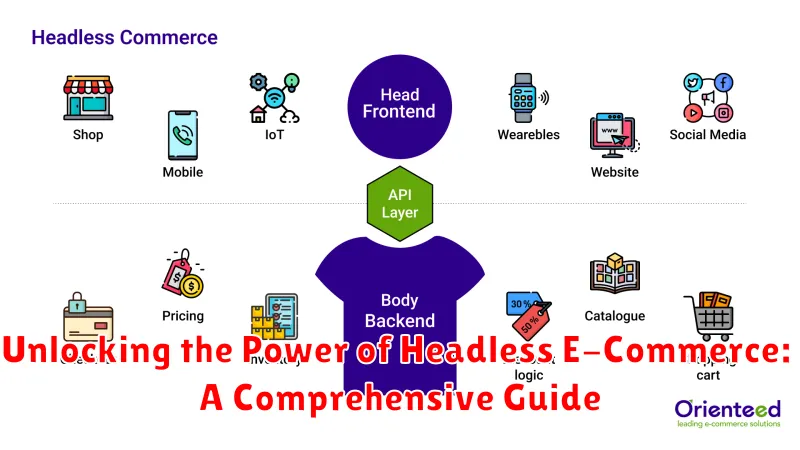In today’s rapidly evolving digital landscape, headless e-commerce has emerged as a transformative approach to online retail. This comprehensive guide delves into the power of headless e-commerce, exploring its core principles, benefits, and practical applications. We will examine how decoupling the front-end presentation layer from the back-end infrastructure empowers businesses to create highly customized and flexible online shopping experiences. Whether you are a seasoned e-commerce professional or just starting to explore the possibilities, understanding headless e-commerce is crucial for staying competitive in the modern market.
This guide will unlock the potential of headless e-commerce by providing a structured overview of its key components and advantages. We will discuss the benefits of enhanced flexibility, improved performance, and seamless integration with various touchpoints. By examining real-world use cases and addressing common implementation challenges, this guide will equip you with the knowledge necessary to determine if headless e-commerce is the right solution for your business needs. From exploring the architectural considerations to understanding the various headless e-commerce platforms available, this resource serves as a starting point for your journey towards leveraging the power of this innovative approach.
What is Headless E-Commerce?
Traditional e-commerce platforms tightly couple the frontend (the customer-facing presentation layer) with the backend (the underlying business logic and data). Headless e-commerce, in contrast, decouples these two components. It essentially separates the “head” (the frontend) from the “body” (the backend).
Think of it like this: the backend becomes a repository of all your product information, customer data, and order management, exposed through APIs (Application Programming Interfaces). The frontend then communicates with the backend via these APIs to retrieve and display the necessary information. This allows businesses to use any frontend technology they prefer, whether it’s a custom-built website, a mobile app, a digital kiosk, or even an Internet of Things (IoT) device.
This separation provides flexibility and scalability, as the frontend can be updated and modified independently from the backend, without affecting core e-commerce functionalities.
How Does Headless E-Commerce Work?
Headless e-commerce operates on the principle of separating the frontend (the “head”) from the backend (the “body”). This decoupling is achieved through an API (Application Programming Interface), which acts as the intermediary between the two. The backend handles all the core e-commerce functionalities such as product management, inventory, orders, and customer data.
When a customer interacts with the frontend, say by browsing products on a mobile app, the frontend sends requests to the backend via the API. The backend processes these requests and returns the necessary data, such as product details or pricing, back to the frontend in a structured format, typically JSON. The frontend then receives this data and displays it to the customer in the desired way.
This decoupling allows businesses to use any frontend technology they prefer, be it a website, mobile app, IoT device, or even a virtual reality experience. The backend remains independent, providing data consistently across all touchpoints.
Benefits of Using a Headless E-Commerce Platform
Headless e-commerce offers a wealth of advantages for businesses looking to enhance their online presence and customer experience. A key benefit is increased flexibility. Decoupling the front-end and back-end allows businesses to customize the user interface and integrate with any touchpoint, creating unique and engaging shopping experiences across various devices.
Improved performance and scalability is another crucial advantage. Headless architecture enables faster loading times and smoother performance, leading to enhanced customer satisfaction and higher conversion rates. It also provides the scalability to handle traffic spikes and future growth without performance degradation.
Omnichannel capabilities are greatly expanded with a headless approach. Businesses can seamlessly integrate their e-commerce platform with various channels, such as social media, IoT devices, and mobile apps, creating a unified and consistent brand experience across all touchpoints.
Finally, headless e-commerce offers greater control and customization. Businesses have complete control over the look and feel of their online store and can tailor the user experience to their specific needs and target audience, leading to a more personalized and engaging shopping journey.
Choosing the Right Headless E-Commerce Solution

Selecting the appropriate headless e-commerce solution requires careful consideration of various factors crucial to your business needs. A thorough evaluation process is essential for maximizing the benefits of this flexible architecture.
Begin by defining your specific requirements. Consider your current and projected sales volume, product catalog size, and required integrations. Understanding these needs will help narrow down the options.
Next, evaluate the API capabilities of each platform. A robust and well-documented API is paramount for seamless communication between the frontend and backend systems. Look for APIs that offer comprehensive access to product data, customer information, and order management functionalities.
Scalability is another critical factor. Choose a solution that can handle future growth and increasing traffic without compromising performance. Ensure the platform can adapt to evolving business needs and technological advancements.
Finally, consider the vendor’s reputation and support offerings. A reliable vendor with a proven track record and excellent customer support can be invaluable during implementation and ongoing operations.
Integrating Headless E-Commerce with Your Existing Systems
Integrating a headless e-commerce platform with your existing systems requires a strategic approach. A key aspect is leveraging APIs (Application Programming Interfaces). APIs act as the bridge, enabling seamless data exchange between the headless platform and other systems like CRM (Customer Relationship Management), ERP (Enterprise Resource Planning), CMS (Content Management System), and marketing automation tools.
Proper API integration ensures data consistency across all platforms. For instance, inventory updates from your ERP automatically reflect on your e-commerce frontend. Similarly, customer data captured through the e-commerce platform can seamlessly flow into your CRM, facilitating personalized marketing efforts.
Choosing the right integration method is crucial. Direct integrations, utilizing custom-built connections, offer maximum flexibility but require more development effort. Alternatively, utilizing pre-built connectors or integration platforms can simplify the process, especially for common systems.
Thorough testing is essential after integration to ensure all systems communicate effectively and data flows accurately. This minimizes disruptions and ensures a smooth transition to the headless architecture.
Customization and Flexibility with Headless E-Commerce
Headless e-commerce offers unparalleled customization and flexibility. Decoupling the frontend from the backend allows businesses to tailor the customer experience to their exact needs without being constrained by the limitations of a traditional platform.
This architectural approach provides the freedom to choose the best technologies for each aspect of the e-commerce experience. Want a cutting-edge JavaScript framework for your storefront? No problem. Need to integrate with a specific inventory management system? Headless makes it possible.
Flexibility extends to design as well. Brands can create unique and engaging user interfaces that align perfectly with their brand identity, free from the rigid templates of monolithic platforms. This results in a more personalized and differentiated customer experience.
With headless, businesses can iterate and adapt quickly to changing market demands. Adding new features and functionalities becomes more streamlined and less disruptive, enabling businesses to stay ahead of the curve and deliver innovative shopping experiences.
SEO Implications of Headless E-Commerce
Headless e-commerce offers significant SEO advantages due to its decoupled architecture. This separation of the frontend and backend allows for greater flexibility in optimizing content and site structure for search engines.
Faster page load speeds are a key benefit, directly impacting search rankings. Headless architecture enables streamlined content delivery, leading to improved Core Web Vitals, a crucial aspect of Google’s ranking algorithm.
Enhanced content management capabilities in a headless setup also contribute to SEO. Marketers can tailor content specifically for the platform or channel it’s presented on, optimizing for relevant keywords and improving discoverability. This granular control improves the overall user experience, another important SEO ranking factor.
However, headless e-commerce introduces complexities. Careful planning is required for URL structure and metadata management to avoid potential SEO pitfalls. Proper implementation and ongoing optimization are crucial for maximizing the SEO benefits of this approach.
Headless E-Commerce for Omnichannel Experiences
Headless e-commerce is a powerful enabler of seamless omnichannel experiences. By decoupling the frontend presentation layer from the backend commerce functionality, businesses gain the flexibility to deliver consistent brand experiences across a multitude of touchpoints.
This means customers can interact with your brand on various platforms – websites, mobile apps, social media, in-store kiosks, and more – and enjoy a unified experience. Data synchronization across channels is crucial for a true omnichannel strategy. Headless facilitates this by enabling a single source of truth for product information, customer data, and inventory.
Consider a customer adding an item to their cart on their mobile device and later completing the purchase on their desktop. A headless architecture makes this possible seamlessly. Furthermore, headless enables personalized experiences tailored to each channel and customer preference. Imagine sending targeted promotions via push notifications based on past browsing behavior. This level of personalization is readily achieved within a headless framework.
Future Trends in Headless E-Commerce

The headless e-commerce landscape is constantly evolving. Several key trends are poised to shape its future, impacting how businesses operate and engage customers.
AI-Powered Personalization
Artificial intelligence will play a larger role in personalizing customer experiences. Expect to see more sophisticated product recommendations, dynamic pricing, and targeted content delivery driven by AI.
Composable Commerce
The shift towards composable commerce, building online stores from best-of-breed services, will accelerate. This approach offers greater flexibility and agility than traditional monolithic platforms.
Expansion of Progressive Web Apps (PWAs)
PWAs will become increasingly prevalent. Offering native app-like experiences within the browser, they enhance user engagement and streamline the shopping journey.
Serverless Architecture
Adopting serverless architectures can improve scalability and reduce operational overhead. This allows businesses to scale resources dynamically based on demand.
AR/VR Integration
While still nascent, integration with augmented reality (AR) and virtual reality (VR) technologies offers unique opportunities to enhance product visualization and create immersive shopping experiences.

